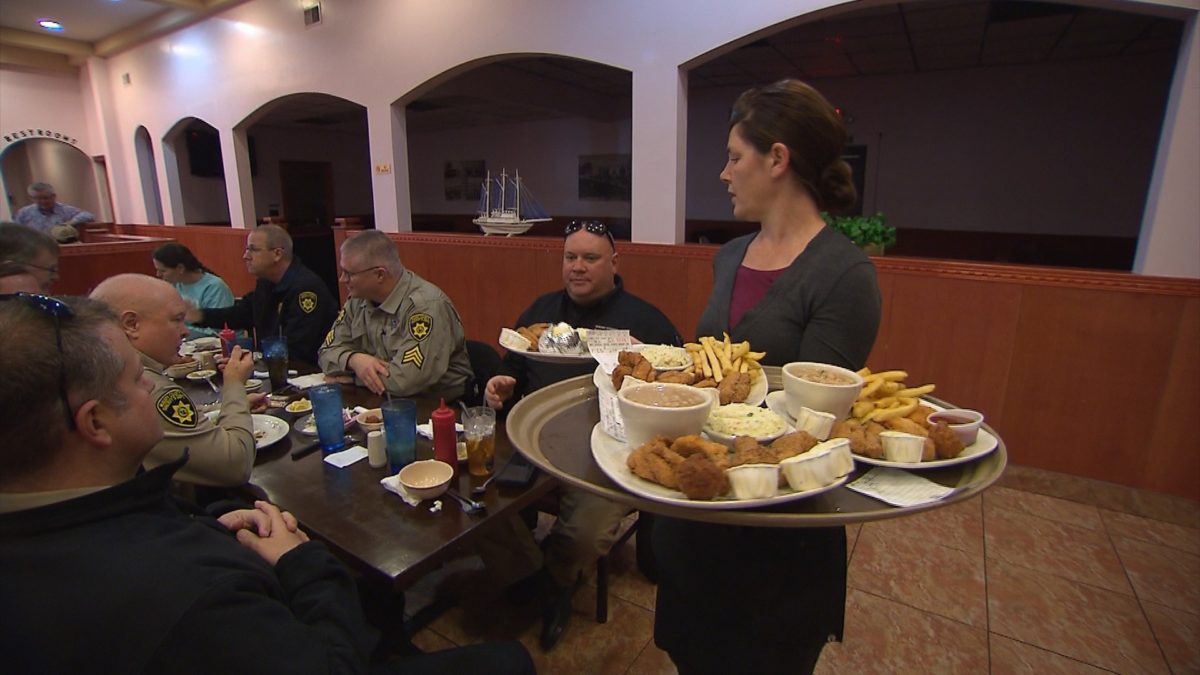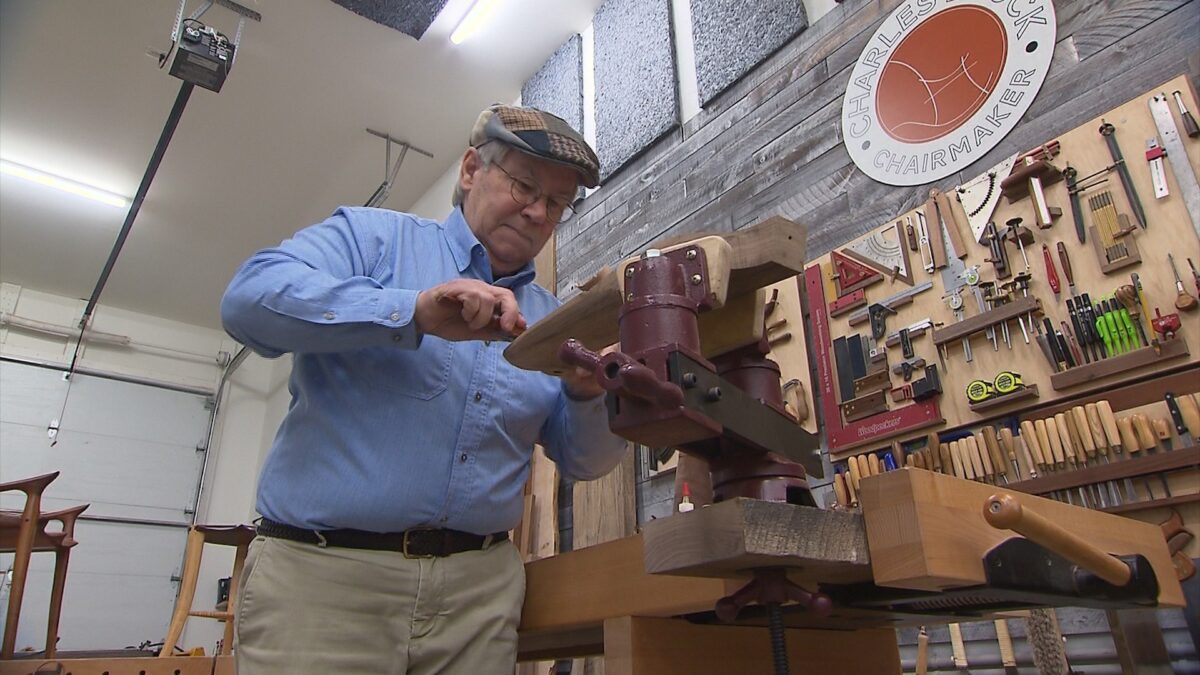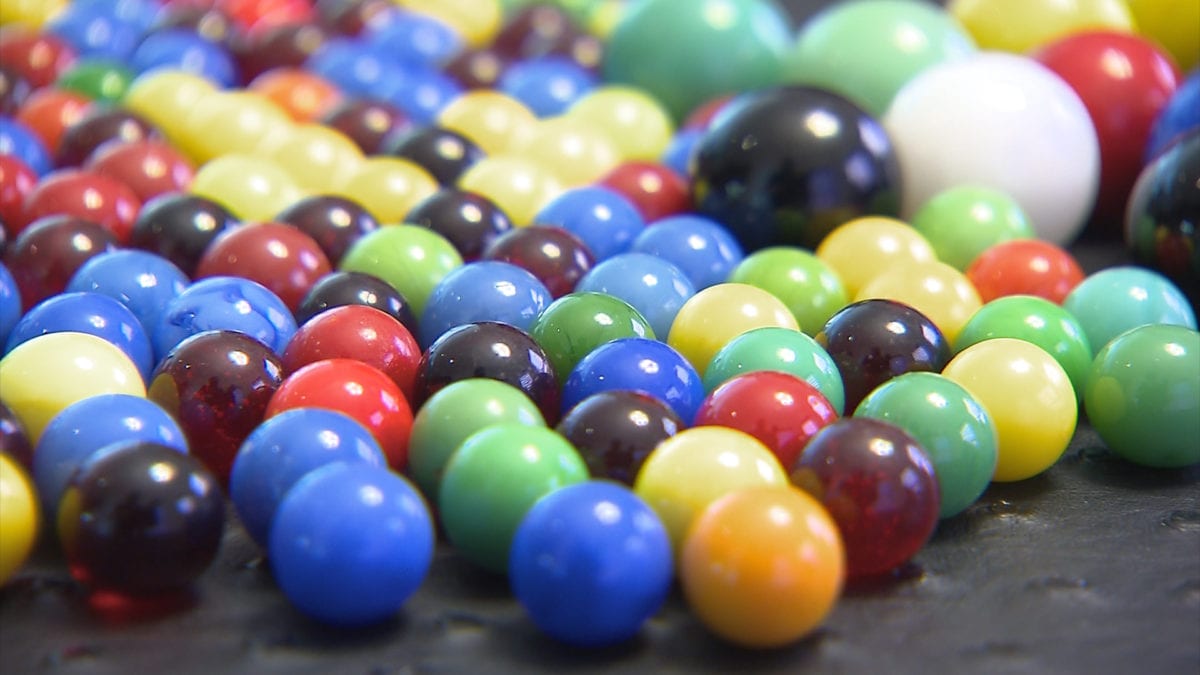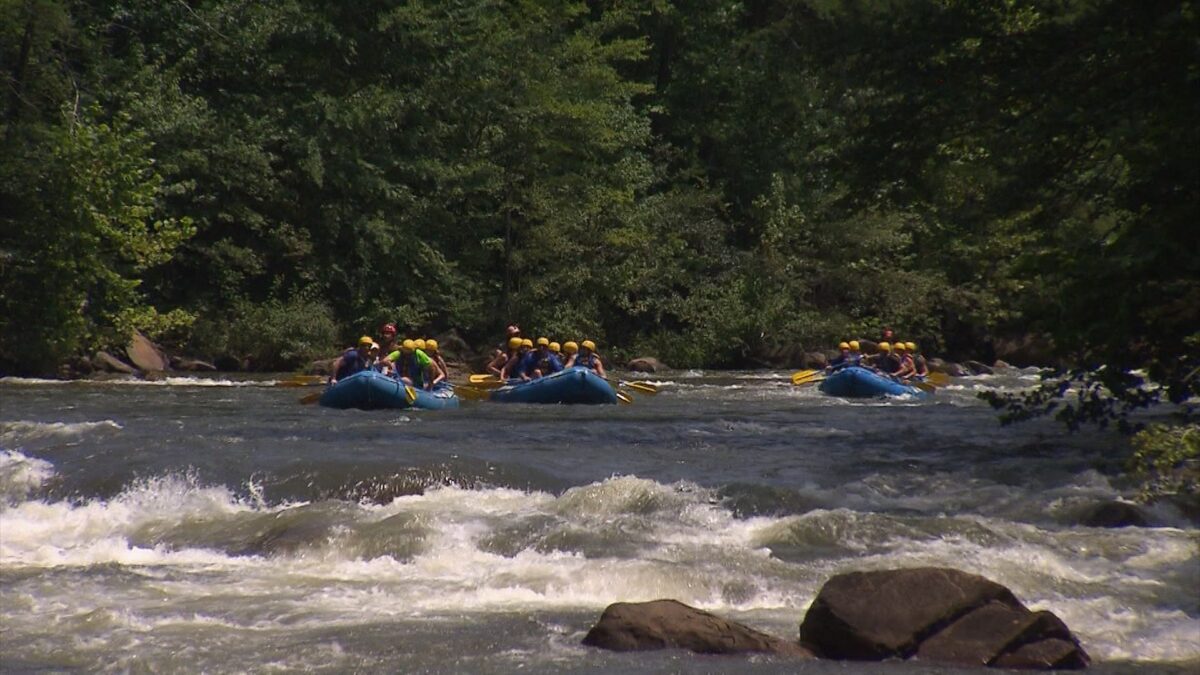Episode 3332
Don't have the PBS App? Click Here
Episode Transcript
- This time on Tennessee Crossroads you'll meet the Rocking Chairman of Spring Hill. Then discover a haven for catfish fans in Columbia. You'll get wet and a little wild on the Ocoee River, and finally meet a Middle Tennessee artist who puts a new spin on an old favorite toy. Hi, I'm Joe Elmore, welcome to the show and to my house or the Crossroads command center for now. Well, in our first story we discover how woodworking is a valuable craft, but most of us would be all thumbs if we tried it. Me, I'd probably lose a thumb. Well, Ed Jones met a wood worker in Spring Hill who's taken his craft to an artistic level while earning the title, Rocking Chairman. - The idea is to look at the chair and have these hard lines and soft lines kind of pull your eye around the chair, as so that you get to enjoy the whole thing, and actually, the chair I think if it's done well, kind of invites you to sit. - [Ed] If anything is more inviting than Charles Brock's rocking chairs, it's the retired school teacher turned craftsman himself. Chuck is one of those genuinely friendly, easy going types that has never met a stranger, and that laid back temperament is perfectly suited for the labor he loves. - I got started while I was teaching school with some tools I borrowed from a neighbor, and I just saw, "Wow, I can do this. "I can have a vision, and I can build it." Building furniture made sense to me, and so I started in the late 70s and I started doing projects for others, building tables and chests and things like that and really pushing my skills. - [Ed] Chuck's skills would be pushed to new heights by a friend who asked him to build a rocking chair. - So I got into looking at rocking chairs and trying to come up with something that he would like, and kinda after two years I got to a point where I had something. I called him up, he came over, looked at it, and he said, "I'll take two." That was an opportunity to move from kind of general woodworking projects into a specialty, and so we're all of a sudden we're building rocking chairs and loving it. - [Ed] And that love shows in every line around every curve of these functional works of art. - I loved them because I can make a rocker and have a friend or somebody sit in it and when they sit down, I'd say 999 times out of 1,000, they're going to smile. They're gonna feel comfortable and that's what you're after. This is some great curly walnut here. When you put some oil and wax on it, you see all of these lines, these curls, where the grain is reversing. - [Ed] At this point in the story, it would seem that Chuck had found what he was after, but realizing his gift for making rockers that make people happy would not be the final chapter. - I started getting close about 15 years ago to retirement, and a couple of things hit me. I had been a teacher, been a woodworker, and if we put those two things together, I can teach woodworking. We're just gonna let the spindles kind of run wild behind it, and I see you've got number seven here. - [Student] Right. - And so that's where that goes, and then number six. One of the great things about it, about teaching, most of my students are my age. They might be 15 years less or even 15 years more, but they always wanted to be able to build this rocker and to give them, help them find purpose, and like I have at a later age. What a great gift for them to switch from being a lawyer or a doctor to doing something that is different, growthful and engaging. - [Ed] The popularity of Chuck's classes inspired him to reach a larger audience through video with his own woodworking series and some pretty famous guests. - It's meant a lot to me. I started woodworking on a practical matter. I worked on a farm with my daddy and I learned saws and hammers. - Wonderful things I like about getting the students out here, they get to see why America is such a, the woodworking heritage here. - Nick Offerman. - Nice to see you Chuck. - Nice to see you. I tell you what, last time I saw you, we were in New York City on a special show for woodworkers. What was that show? - Martha Stewart. - Yeah, Martha Stewart. The Martha Stewart Show thing was the only way I've ever won an argument with my wife. Now, this isn't gonna be on there ? - [Ed] Well, sorry, Charlie, I couldn't resist. - I kept checking my phone and she said, "Put that thing up. "I'm so tired of you checking that phone. "Nobody is going to call you "of any importance this afternoon." About that time she just finished with that, the phone rang and the lady introduced herself as a segment producer for Martha Stewart Show, so I hung up, my wife said, "Well, who was that?" I said, "That was the Martha Stewart Show, "I'm gonna be on there next week." So she's never complained. - [Ed] But fame hasn't changed Charles Brock one bit. He remains a humble craftsman, content to share his incredible talent with others. - The lord had a better plan for me than I had for myself, and it really just, it's gotta be that because I went from the garage woodworker to teaching classes, to being on The Martha Stewart Show, to having my own show. So you can't really beat that, especially between the ages of 60 and 70 years old. All I have to sell, really, besides a chair to sit in, are dreams that they can build it too, have a legacy. - Thanks, Ed. Well here's a dining destination to put on your to-do list when it's okay to go out and about. A restaurant has to have something going for it when it has a remote location, but hoards of people coming in everyday. Well, Tammi Arender found such a place down in Columbia. - Hey. - Hello. - [Hostess] How are y'all doing? - Good, and you? - Good. - I got y'all some hushpuppies. - Hey. - Hey, brother. - [Gary] How you doing? - I'm doing all right. How are y'all? - [Gary] Oh, we're hanging right in there. - Hanging in there? - [Tammi] You may think with a name like Gary Bass there would automatically be a fondness for fish, and yes, there is, but Gary and his wife Rhonda specialize in catfish, not bass. - The main draw is our catfish. We make our own batter for the catfish and we just lightly batter it. You get a lot more meat than you do batter. - [Tammi] Gary and Rhonda are the principals at Catfish Campus in Columbia, a mainstay in Muletown since 1991. - There venues and all was a school with all the fish in the desk like a school of fish. They go in schools, and so that's how they got the name. - [Tammi] The Basses started in the restaurant business in a small town in northeast Arkansas. - We have another location in Arkansas. A little town called Caldwell, Arkansas that's right off of interstate 40. A little town of 311 people, I believe, and a famous country singer was from there. A guy named Charlie Rich, they called him the Silver Fox, and he was born right there close to where the restaurant's at. And we'll feed somewhere around 1,500, 2,000 people a week in a little town of 311 people. - [Tammi] Rhonda doesn't have a culinary degree, but her upbringing taught her everything she needed to know about good, southern home cooking. - [Rhonda] I growed up in a family of 10 kids, and I'm one of the older ones, so we had to do everything and learned to cook early and whatever, and I've always enjoyed it. - [Tammi] And she still enjoys it. You can often find her in the kitchen, even though the employees know the recipes by heart. Some of these employees have been a part of this establishment since they were kids. - [Rhonda] All the years, I mean, we've seen them grow up and babies that was here work for me now, and one of my managers, my day manager, he started for me when he was 15 year old and now he has, when he started of course he was a busboy, a dishwasher, and he's worked his way up as a manager, and then he has two sons that works for us. - So the quintessential southern lunch. Got the turnip greens, the coleslaw, and that crispy, fried catfish. I cannot wait to dig in. Although catfish is the calling card at this cafe, you can get just about anything your taste buds desire. Steaks, seafood, chicken, and pork chops and dessert. Don't dare forget the desserts, and some people just come for the sides. - [Rhonda] It is southern cooking, and like our hushpuppies, our slaw, everything we do from scratch, make our own, and so you're not getting prepackaged, frozen stuff. It's all fresh. - A lot of people thought we just shut down. They didn't realize we'd moved back off the road. - [Customer] It took a little while, but-- - But see, we was at-- - [Customer] Good food and good service should bring you. I don't care where you go. - Yeah, right. - [Tammi] You'll seldom find Gary in the kitchen. He's all about public relations, literally. - How are you, Mr. Bass? - I'm doing fine. - Good to see you, sir. - [Gary] I'm a PR guy, I guess you could say. I love the customers and I love to talk to them, find out where they're from, and of course we've made a lot of friends over the years and we've got people that come in almost every day to eat. And we have people every week, if some of them don't show up on Friday night, we're, "Oh no, what's wrong with this guy or this lady?" We know them by name, not just by faces. We're just friends with a lot of people in the community. - [Tammi] Giving back to the community is also important. The Basses get to know their customers so well, they know when something is wrong or when someone is sick. - They are just almost like family. Yeah, when some of them are sick, I'll take them a meal or feed their whole family. I'll just take them what we call a family pack of chicken or fish or we'll mix it and make a combo out of it. And we've had a lot of people over the years that were close friends or good customers and when they get sick, couldn't go anywhere, I'd take them a meal every day. - [Tammi] That's really putting a restaurant to the test, and if you're a student of southern cooking, then a trip to Catfish Campus will get you an A plus every time. - Well, of course after Tammi produced that story, they had to shut down the dining room for obvious reasons, but they still offer carry out. Which reminds me, that's a good way to show support for your local restaurant servers. Now here's an idea for a great getaway when it's time to get out. If you don't mind getting wet, just head down to the Ocoee River for some natural beauty and naturally thrilling white water rafting. It's just a bed of rocks when TVA's using it to make electricity, but when they release water from the dams, the river roars to life, and this gorge becomes a premier sports destination for kayaking and white water rafting. - The thing about the Ocoee is that it's so consistent. The middle section is something special. It's just rapid after rapid and you're constantly doing something. After all these years we've really figured out ways to make the most out of all these rapids. - [Joe] That's Jake Rogers, a young yet veteran guide of Ocoee Rafting, the oldest of 22 outfitters along the river. Every season owner Angie Arp welcomes thousands of adventure seekers, many of which are first timers. - They're a little nervous to start with, but once they go, they come back, and I ask them, I'm in the office I ask them, "Did you have a good time?" "Oh, we had a blast. "We had so much fun." Once they do it and get over that nervousness and they feel comfortable with their guide, they're fine. - [Joe] After you check in at the welcome center and grab your gear, there's a group safety talk with a little bit of levity thrown in. - You'll find yourself underneath the raft. If you are underneath the raft, please come on out from underneath the raft, okay? There are exits at the front, back and both sides. Pick one, but don't try and go up. - [Joe] Next, the five mile ride upstream to the dam. - Show of hands, who's never done anything like this before? All right, well, this is real easy. This is called a bus ride. If you can keep your hands and feet inside the windows at all times, no running up and down the aisle, that would be phenomenal. Thank you very much. - [Joe] Before the launch, Jake has a few more pointers for our crew. - Sit down and the further and tighter the better. Let me see what we got. Just like that. - [Joe] Most rafts carry six people, ours is only populated by our guy Jake, a couple from West Virginia, Patrick and Angie, Paul manning the GoPro, and me. - [Jake] We're gonna start of at Grumpy's Ledge, that's the very first rapid and you're really put straight into it. There's no practice time. You go straight into the class III rapid. - [Joe] The guides have nice little names for the places you encounter, like Broken Nose, Table Saw, and Hell Hole. - [Jake] Alright, stay down right there. Go ahead and straighten out with the surf. - [Joe] There are only a few commands you need to know, like paddle forward, you hear that a lot. And another one, hit the deck, which you'd best obey. - [Jake] Hit the deck. - [Man] Whoa. - Water line went down 'cause I swallowed part of it. - [Man] Yeah. - Whew. I didn't know we'd get wet. Of course, you gotta enjoy it while you can. - Whoa. - Whoo-hoo. - I got a new paddle command for you guys, it's called left side forward, right side back. Left side forward, right side back, that means that Joe and Patrick, you guys are gonna go forward really hard, Amy and I, we're gonna go back really hard, and that's what's gonna spin us around all the way through this rapid. - [Joe] Eventually we passed the Ecoee's powerhouse. - [Jake] And that's the powerhouse. - [Joe] The river altitude drops about 250 feet on the five mile journey. The water level's always the same thanks to TVA, but the success of the ride is up to your guide. - [Jake] It really comes down to a game of inches. I mean, it's inches of where you're keeping your boat to stay in the route line and also work your people as little as possible. I try not to get people huffing and puffing out there and just wearing themselves out. - [Joe] Before you know it, an exhilarating hour and a half has passed and it's the end of the line. You're a little tired, totally wet, and full of wild, wonderful memories that'll stay afloat for years to come. - Joe, it was great to have you. - Beautiful, man. - All right, good. I'm glad you guys enjoyed it. - [Tour Guide] Thank you guys so much. If you see us on social media, click like, swipe right. Thank you and good night. - [Passengers] Whoo-hoo. - Remember the days before video games when a bag of marbles could keep kids occupied for hours? Well, recently Rob Wilds met a Middle Tennessee artist whose love for marbles led to some beautiful creative jewelry. - [Rob] You're supposed to get on your knees to play marbles, but Gerald Witcher has taken pity on an old man and his creaky knees and set up a game on his pool table. - All right, bingo. - I don't think you should play marbles with a guy who collects 'em, should ya? Aw, that's pitiful. Oh, man. Oh, man . Oh, man. Oh, man. - There's mulligans in marbles so go again. - [Rob] It's fun to play marbles with Gerald Witcher, in fact, it was fun to play marbles when you were a kid. He played as a boy and became fascinated with glass and then marbles, and he isn't the only one by any means. - George Washington, Thomas Jefferson, John Quincy Adams, Abraham Lincoln, were all very good marble players, and so it's not something necessarily new. A lot of us think of marble, playing marbles in the 50s and 60s. And it sorta died out now, it doesn't have a plug on it, and you don't see many kids out in the dirt playing like they used to, but I think just the fascination with glass itself. An old jar of marbles frequently sparks a conversation about, "I had some of those or my parents," or it's just nostalgia. I collected marbles in the past as a kid. I've always enjoyed glass and colors and patterns and those kind of things, and I've been fascinated with marbles for some time. - [Rob] Gerald traveled to West Virginia to the last full-time marble maker in the country, the Marble King company, which has been in business a long time and was featured in a documentary made by the State of West Virginia back in 1991. - [Gerald] I got very interested in making marbles and actually participated in a marble run with a group of investors, and so been able to work with the equipment and make marbles and was looking for something to do with the scrap glass that we had, and wound up discovering that you can actually melt glass in a microwave. And through the process of trial and error developed into a business. - [Rob] Gerald's jewelry company is known as Second Chance Marble Works, a second chance for the marbles, sure, and for the one time boys and girls who fondly remember those dusty days down in the school yard, those shiny fascinating balls of glass. So Gerald decided he could repurpose old marbles himself. - [Gerald] Once I discovered that I could actually melt glass in a microwave, I began to experiment things. I could make cuff links, I could make, you'll see there are molds that you could make like spinning tops for children's toys, but we sorta stuck on making pendants. You could buy round molds and control the size. One of the variables is I had to figure out how much glass to volume because obviously you don't want it overflowing, and if you don't put enough glass volume in, it will not conform to the mold. So once I was able to figure that process out from trial and error, then it was a process of mixing colors, mixing patterns, what things go together. - [Rob] Gerald learned to cut some of the marbles to make for even more dynamic designs. - Being able to do that allowed me to do so much more, so instead of just melting a single marble and really limiting the patterns that I could have, once I was able to control the volume of glass and knew what glass would be compatible, then it really opened up a full spectrum of what you can make. Now this is the pendant we were trying to make. Knowing that we're using red, black and tan, and the fact that we had a certain chemical to give it that rough texture along with the smooth. And now that it's cooked and cooled enough, this is the finished product. Then we put it out here to cool, and this is how this one turned out with the dyed cork frit, and this one started from a clear blue marble. Many people decorate with marbles now. You walk in and somebody's, their home's got a candy jar or an old jar of marbles. It frequently sparks a conversation about, "I had some of those or my parents," or it's just nostalgia. Of course, their attracted to the colors and the patterns and those kind of things, but then you start a conversation and when you tell them they're made from old marbles, the conversation's going all kind of directions then. I've had people have marbles in their car, "Wait, I want you to look at these marbles." You just never know, but the fascination with the fact that it's a toy that they identify with as a child and now it's been repurposed into something that's a piece of jewelry. - [Rob] Beautiful pieces of jewelry for people who are used to marbles, not as a game, but as decorative pieces of the past. - Well, that's it for our home edition of Tennessee Crossroads. I hope you enjoyed it. I hope you'll join us next week. Meanwhile, take care and be safe.
Tennessee Crossroads
April 16, 2020
Season 33 | Episode 32
This week on Tennessee Crossroads, meet a Columbia artist with a ROCKIN' business. Discover a catfish restaurant off the beaten path in Columbia. Take in some white water rafting on the Ocoee River. Last but not least, see the work of an artist whose fascination with a child's toy has resulted in some colorful and beautiful pieces of jewelry. Brought to you by Nashville Public Television!




